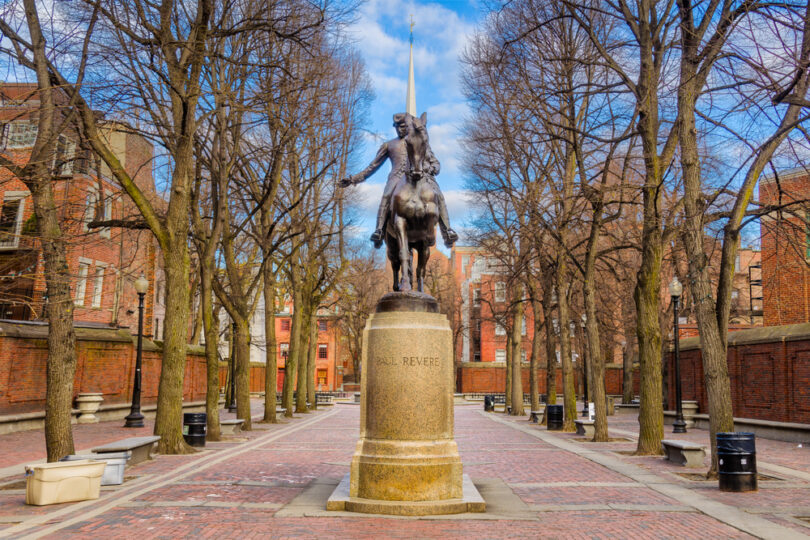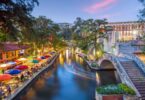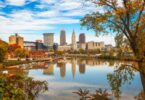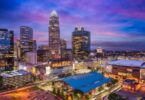Boston is often called the birthplace of the American Revolution — and for good reason. It was here that tensions between the colonists and the British erupted into historic events like the Boston Massacre, the Boston Tea Party, and the Battle of Bunker Hill. Walking the Freedom Trail, visitors can explore iconic sites that tell the story of the city’s role in the fight for independence.
But Boston wasn’t the only place that shaped the Revolution. Just beyond the city, towns like Lexington and Concord saw the first shots of the war, while key military strategies played out in Cambridge, Somerville, and Dorchester. Along the coast, places like Salem and Marblehead contributed through naval warfare and privateering. Patriots, Minutemen, and even George Washington himself left their mark across Massachusetts.
From battlefields and colonial taverns to secret meeting houses and historic harbors, these sites offer a deeper understanding of the struggle for independence. Whether you’re a devoted history buff or just curious about America’s past, these must-visit locations bring the Revolution to life.
Revolutionary Boston

Quincy Market and Faneuil Hall, Boston
Before shots were fired in Lexington and Concord, Boston was already at the center of the growing resistance against British rule. Colonists gathered in meeting halls, taverns, and churches to debate independence, while key events like the Boston Massacre and Boston Tea Party fueled revolutionary fervor. Today, visitors can explore Boston’s colonial past through these must-see sites.
Old North Church, famous for its role in Paul Revere’s midnight ride, still stands in the North End. This is where two lanterns were hung on April 18, 1775, signaling that British troops were advancing by sea. Nearby, the Paul Revere House offers a glimpse into the patriot’s life and 18th-century Boston.
At Faneuil Hall, known as the “Cradle of Liberty,” fiery speeches stirred public opinion against British policies. A short walk away, the Granary Burying Ground serves as the final resting place of Paul Revere, Samuel Adams, and John Hancock. For a more immersive experience, the Boston Tea Party Ships & Museum lets visitors relive the moment when enraged colonists defiantly dumped British tea into the harbor.
Lexington & Concord — The First Assault

Old North Bridge, Minute Man National Historical Park, Concord
On April 19, 1775, the war for American independence began in two small Massachusetts towns: Lexington and Concord. British troops, under orders to seize colonial weapons and arrest patriot leaders, marched from Boston, but they were met with resistance from local militia. The resulting clashes became known as the first battles of the American Revolution.
At Lexington Green, a small park in the center of town, the first shots were fired at sunrise. With approximately 700 British troops facing just 77 Minutemen, the brief but deadly skirmish left eight colonists dead. From there, the British advanced to Concord, where the colonial militia had gathered in greater numbers. At the North Bridge, the Minutemen fired upon the British, forcing them to retreat. This marked the first time colonial soldiers had deliberately attacked British forces.
Today, visitors can walk in the footsteps of the revolutionaries at Minute Man National Historical Park. The five-mile Battle Road Trail follows the path of the British retreat, passing historic homes and taverns that witnessed the chaos. Places like Buckman Tavern in Lexington and Hartwell Tavern along Battle Road provide a glimpse into colonial life at the dawn of the Revolution.
Cambridge & Dorchester — Washington Takes Command

Longfellow House, Cambridge, Massachusetts
After the battles of Lexington and Concord, Boston remained under British control, but colonial forces quickly surrounded the city. Over the next several months, a standoff known as the Siege of Boston unfolded, and in July 1775, General George Washington arrived to take command of the newly formed Continental Army. His headquarters was established at a grand Georgian home in Cambridge, now known as the Longfellow House – Washington’s Headquarters National Historic Site. Nearby, on Cambridge Common, a statue marks the spot where Washington formally assumed leadership of the army.
To maintain their grip on Boston, British troops fortified key points, including Prospect Hill in present-day Somerville. It was here, in January 1776, that colonial forces reportedly raised the Grand Union Flag — the first flag to represent the united colonies. But the real turning point came in March 1776, when colonial troops, using cannons transported from Fort Ticonderoga, fortified Dorchester Heights. The strategic high ground gave Washington the advantage he needed, forcing the British to evacuate Boston on March 17, a day still celebrated as Evacuation Day.
Salem & Medford — Resistance Beyond the Battlefield

Custom House, Salem Maritime National Historic Site
Not all Revolutionary War efforts took place on battlefields. Some towns contributed to the fight through naval warfare, political organizing, and economic disruption. Salem and Medford both played essential roles in supporting the patriots, though in very different ways.
Salem was a major colonial seaport, and when the war broke out, it became a center for privateering. With the British navy controlling Boston Harbor, Salem’s port provided a key base for American privateers — civilian ships authorized to attack British merchant vessels. These raids crippled British supply lines and boosted the colonial war effort. Visitors today can explore Derby Wharf and the historic Salem Custom House to learn more about the town’s seafaring contributions.
Medford, meanwhile, was home to both revolutionaries and Loyalists alike. The Isaac Royall House, owned by a prominent Loyalist family, was abandoned when its owners fled to England. The estate also contains one of the last remaining slave quarters in New England, reflecting the often-overlooked ties between the war and slavery.
You Might Also Enjoy: Boston Travel Brief: What to Know Before You Go
Marblehead — The Coastal Patriots

Marblehead, Massachusetts
While towns like Lexington and Concord are famous for their battles, Marblehead played a crucial but often overlooked role in the Revolutionary War. This coastal town’s skilled seafarers directly contributed to some of the war’s most pivotal moments, including one of George Washington’s greatest military victories.
Marblehead was home to the Marblehead Regiment, a group of fishermen and sailors led by Colonel John Glover. These men became essential to the war effort, using their maritime expertise to transport troops and supplies. Their most famous mission came in December 1776, when they ferried Washington and his army across the icy Delaware River for a surprise attack on British forces in Trenton. This daring maneuver led to a major victory that helped turn the tide of the war.
Today, visitors can explore Old Burial Hill, where many of Marblehead’s patriots are laid to rest. The picturesque site offers sweeping coastal views, a reminder of the town’s deep connection to the sea. Through both military service and maritime support, Marblehead’s residents played an essential role in securing American independence.
FAQs:
Q: What is the best way to get to Lexington and Concord from Boston?
A: Lexington and Concord are about 30 minutes from Boston by car. Visitors can also take the MBTA commuter rail from North Station to Concord Station. Another option is the seasonal Liberty Ride Trolley, which offers guided tours of key sites.
Q: Are the historic sites free to visit?
A: Many sites, including Lexington Green, Minute Man National Historical Park, and Battle Road Trail, are free. Some locations, like the Paul Revere House and the Boston Tea Party Ships & Museum, charge admission.
Q: How much time should I plan for visiting Lexington and Concord?
A: Plan for at least half a day to visit key sites like Lexington Green, the North Bridge, and the Battle Road Trail. A full day allows time for museum visits and exploring colonial homes.
Q: What’s the best time of year to visit Revolutionary War sites?
A: Spring and fall offer pleasant weather and seasonal reenactments. The summer months are popular but can be crowded. Some sites, including Minute Man National Historical Park, offer guided tours from Memorial Day through October.
Q: Are these sites accessible for visitors with mobility concerns?
A: Many locations, including Faneuil Hall, the Paul Revere House, and the Minute Man Visitor Center, have accessibility accommodations. Some outdoor trails and historic homes may have uneven terrain or stairs.
Q: Can I walk or bike between Lexington and Concord?
A: Yes, the Minuteman Bikeway and Battle Road Trail offer scenic walking and biking routes. The Battle Road Trail, which follows the path of the British retreat, is about five miles long and connects several key sites.
Q: Are there guided tours available?
A: Yes, Boston offers Freedom Trail walking tours, and ranger-led tours are available at Minute Man National Historical Park. Private tour companies also provide guided experiences in Lexington and Concord.
Did we leave off your favorite Revolutionary War site in Massachusetts? Tell us about it in the comments below!








